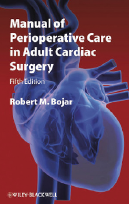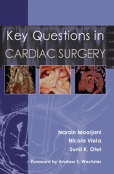Manual of perioperative care in adult cardiac surgery, 5th edition
Author: Bojar, RM
Publisher: Wiley-Blackwell, 2010
ISBN: 978-1-4443-3143-1
Price: £42.99
 This fifth edition of a popular manual has been extensively revised. It is densely packed with information in its 820 pages.
This fifth edition of a popular manual has been extensively revised. It is densely packed with information in its 820 pages.
A very comprehensive and up-to-date synopsis of adult cardiac surgical disease is given in the first chapter with subsequent chapters dealing with diagnostic techniques and virtually every aspect of perioperative care. A chapter dealing with preoperative considerations, provides an excellent discussion of risk assessment and informed consent, including a summary of risk models in cardiac surgery. It gives very precise details of preoperative orders and check lists.
The chapter on cardiac anaesthesia includes a large section on intraoperative transoesophageal echocardiography and provides a North American approach to anaesthesia itself. There are excellent sections on heparin monitoring and the management of off-pump coronary surgery; comprehensive chapters on different types of cardiopulmonary bypass circuits and myocardial protection which are brief and authoritative; and a particularly good chapter on early postoperative care with a discussion for a fast track protocol. The management of postoperative mediastinal bleeding is very clear and practical. Throughout the author employs very useful tables and diagrams and avoids very long lists of drugs.
Respiratory management is covered in an exceptionally clear chapter on different modes of ventilation, weaning from ventilation, and post-extubation respiratory care. Postoperative cardiovascular management has an up-to-date review of ventricular assist devices and ECMO with useful algorithms. The section on right ventricular dysfunction is clear and helpful. The last two chapters deal with complications arising in other body systems with an outstanding section on acute kidney injury. Surprisingly, there is virtually no mention of liver failure which, while very uncommon, is an area which is relevant to severe right ventricular dysfunction.
Thus the book achieves its objective of being a practical manual while providing a succinct background of the principles, which underlie the algorithms that are so clearly displayed. If there is one overall criticism, it is in the quality of some of the illustrations and the absence of any colour. While I appreciate that this would increase the cost significantly, a black and white picture of a tetrofosmin perfusion scan has little impact. This should not detract from the major achievement of packing so much information in an accessible manner into a small space. Young trainees in cardiac surgery, anaesthesia and intensive care, will find this an invaluable resource.
Professor John Pepper
Department of Surgery, Royal Brompton Hospital, Sydney Street, London, SW3 6NP
Key questions in cardiac surgery
Authors: Moorjani N, Viola N, Ohri SK.
Publisher: TFM Publishing Ltd, 2011
ISBN: 978-1-903378-69-4
Price: £60.00
 Although this book is aimed at cardiac surgical trainees and residents, the authors’ refreshing approach of posing questions and answers as a teaching tool makes this a joy to read for someone who has been practicing cardiac surgery for over 30 years. It is beautifully presented with exceptionally clear diagrams interposed with photographs, a combination which works well. The use of line diagrams with colour results in cartoons, which help to clarify specific anatomical details.
Although this book is aimed at cardiac surgical trainees and residents, the authors’ refreshing approach of posing questions and answers as a teaching tool makes this a joy to read for someone who has been practicing cardiac surgery for over 30 years. It is beautifully presented with exceptionally clear diagrams interposed with photographs, a combination which works well. The use of line diagrams with colour results in cartoons, which help to clarify specific anatomical details.
The questions are the sort which crop up in every day practice, although some are designed to bring the reader up short, such as “How is the heart formed embryologically?” At the end of each chapter is a concise but carefully compiled list of recommended reading. In modern day cardiology and cardiac surgery, the electrocardiogram (ECG) receives only a cursory glance from those who are not electrophysiologists so it was a surprise to find such an excellent chapter on the subject, including guidance on how to interpret an exercise ECG. A chapter on echocardiography is up-to-date with details of semi-quantitative assessment of valvular regurgitation, together with highly practical points such as the distinction between a pericardial and a pleural effusion. Cardiac physiology is well reviewed in an early chapter and appears again within the cardiac catheterisation chapter where measurement of cardiac output and shunt calculations are clearly explained.
There are three chapters, which deal with cardiopulmonary bypass and its complications. Here again, there are very clear diagrams which explain well cannulation and venting. The approach is consistently very practical indicating the authors’ daily participation in the cut and thrust of surgery. In the sections on specific groups of diseases there is a strong reliance on evidence base and guidelines. It was therefore a little surprising to find no mention of informed consent or the details of risk assessment. There seem to be very few errors but I was struck by the bald statement that bicuspid aortic valve has an autosomal dominant inheritance pattern. There are an excellent set of questions relating to important trials which are very contemporary.
A number of useful appendices are provided including a clear summary of EuroSCORE. Overall, this is an exceptionally well-produced book which is a delight to read and is likely to run to several more editions.
Professor John Pepper
Department of Surgery, Royal Brompton Hospital, London, SW3 6NP
